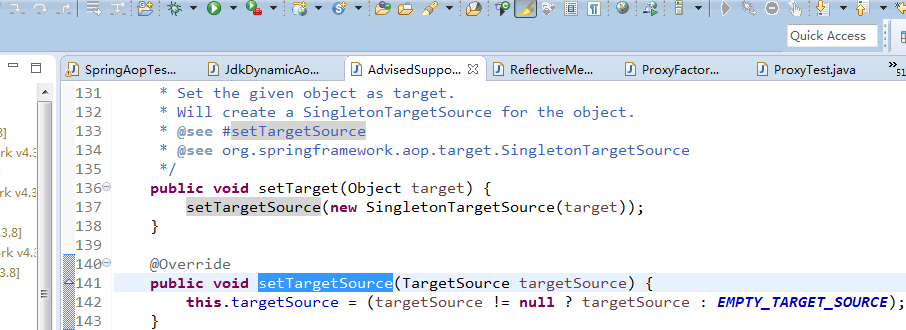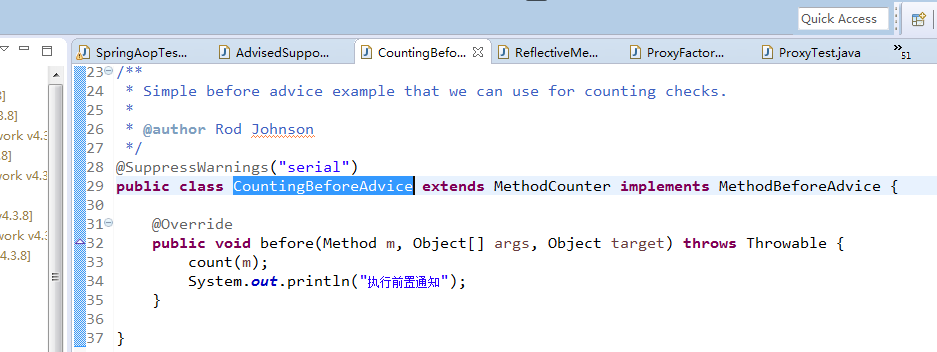Spring Aop源码分析
最近看了SpringAop的源码实现 大概记录一下aop的源码流程
创建一个最简单的一个测试类
package com.zcg.learn.Test;
import org.aopalliance.aop.Advice;
import org.junit.Test;
import org.springframework.aop.aspectj.AspectJExpressionPointcutAdvisor;
import org.springframework.aop.aspectj.annotation.AspectJProxyFactory;
import org.springframework.aop.framework.Advised;
import org.springframework.aop.framework.ProxyFactory;
import org.springframework.tests.aop.advice.CountingAfterReturningAdvice;
import org.springframework.tests.aop.advice.CountingBeforeAdvice;
import com.zcg.learn.UserService;
import com.zcg.learn.UserServiceImpl;
/**
* SpringAop源码分析测试类
* @author zcg
* 2018/3/1
*
*/
public class SpringAopTest {
/**
* 创建代理
*/
@Test
public void createProxyTest() {
Object target = new UserServiceImpl();
ProxyFactory pf = new ProxyFactory(target);
//CountingBeforeAdvice 前置通知计数器
CountingBeforeAdvice countingBeforeAdvice = new CountingBeforeAdvice();
pf.addAdvice(countingBeforeAdvice);
UserService service = (UserService) pf.getProxy();
service.addUser();
}
/**
* 动态添加 移除通知
*/
@Test
public void createProxyTest2() {
Object target = new UserServiceImpl();
ProxyFactory pf = new ProxyFactory(target);
UserService service = (UserService) pf.getProxy();
Advised advised = (Advised) service;
CountingBeforeAdvice countingBeforeAdvice = new CountingBeforeAdvice();
CountingAfterReturningAdvice countingAfterReturningAdvice = new CountingAfterReturningAdvice();
advised.addAdvice(countingAfterReturningAdvice);
advised.addAdvice(countingBeforeAdvice);
service.addUser();
advised.removeAdvice(countingAfterReturningAdvice);
service.addUser();
}
@Test
public void createProxyAspectJByTest() {
Object target = new UserServiceImpl();
AspectJProxyFactory pf = new AspectJProxyFactory(target);
AspectJExpressionPointcutAdvisor advisor = new AspectJExpressionPointcutAdvisor();
advisor.setExpression("execution(* *.addUser(..))");
CountingBeforeAdvice counting = new CountingBeforeAdvice();
advisor.setAdvice(counting);
pf.addAdvisor(advisor);
UserService userService = pf.getProxy();
userService.addUser();
/**
* advice 通知拦截器
* advisor 通知加切入点适配器
*/
}
}
其中测试方式
@Test
public void createProxyTest() {
Object target = new UserServiceImpl();
ProxyFactory pf = new ProxyFactory(target);
//CountingBeforeAdvice 前置通知计数器
CountingBeforeAdvice countingBeforeAdvice = new CountingBeforeAdvice();
pf.addAdvice(countingBeforeAdvice);
UserService service = (UserService) pf.getProxy();
service.addUser();
}
1.target 以构造参数的形式放入在ProxyFactory中,实际上将该tartget放入在AdvisedSupport类中

2.countingBeforeAdvice 为Spring Aop自带的前置通知计数
3.1 UserService service = (UserService) pf.getProxy();从中获取代理类
ProxyFactory类中 extends ProxyCreatorSupport
/*
* 代理生成工厂
*/
@SuppressWarnings("serial")
public class ProxyFactory extends ProxyCreatorSupport {
/**
* Create a new proxy according to the settings in this factory.
* <p>Can be called repeatedly. Effect will vary if we've added
* or removed interfaces. Can add and remove interceptors.
* <p>Uses a default class loader: Usually, the thread context class loader
* (if necessary for proxy creation).
* @return the proxy object
*/
public Object getProxy() {
return createAopProxy().getProxy();
}
}
3.2 createAopProxy()方法是父类ProxyCreatorSupport里面的方法
protected final synchronized AopProxy createAopProxy() {
if (!this.active) {
activate();
}
//得到Aop代理工厂和在当前代理工厂创建该代理类
return getAopProxyFactory().createAopProxy(this);
}
其中getAopProxyFactory().createAopProxy(this)在DefaultAopProxyFa1ctory类中执行 具体代码如下
@SuppressWarnings("serial")
public class DefaultAopProxyFactory implements AopProxyFactory, Serializable {
@Override
public AopProxy createAopProxy(AdvisedSupport config) throws AopConfigException {
if (config.isOptimize() || config.isProxyTargetClass() || hasNoUserSuppliedProxyInterfaces(config)) {
Class<?> targetClass = config.getTargetClass();
if (targetClass == null) {
throw new AopConfigException("TargetSource cannot determine target class: " +
"Either an interface or a target is required for proxy creation.");
}
//r如果目标类有接口或者是代理类,则走jdk的动态代理 否则走cglib的动态代理
if (targetClass.isInterface() || Proxy.isProxyClass(targetClass)) {
return new JdkDynamicAopProxy(config);
}
return new ObjenesisCglibAopProxy(config);
}
else {
return new JdkDynamicAopProxy(config);
}
}
/**
* Determine whether the supplied {@link AdvisedSupport} has only the
* {@link org.springframework.aop.SpringProxy} interface specified
* (or no proxy interfaces specified at all).
*/
private boolean hasNoUserSuppliedProxyInterfaces(AdvisedSupport config) {
Class<?>[] ifcs = config.getProxiedInterfaces();
return (ifcs.length == 0 || (ifcs.length == 1 && SpringProxy.class.isAssignableFrom(ifcs[0])));
}
}
3.3 JdkDynamicAopProxy类实现了InvocationHandler 对invoke进行的重写 核心代码如下
final class JdkDynamicAopProxy implements AopProxy, InvocationHandler, Serializable {
@Override
public Object invoke(Object proxy, Method method, Object[] args) throws Throwable {
MethodInvocation invocation;
Object oldProxy = null;
boolean setProxyContext = false;
TargetSource targetSource = this.advised.targetSource;
Class<?> targetClass = null;
Object target = null;
try {
if (!this.equalsDefined && AopUtils.isEqualsMethod(method)) {
// The target does not implement the equals(Object) method itself.
return equals(args[0]);
}
else if (!this.hashCodeDefined && AopUtils.isHashCodeMethod(method)) {
// The target does not implement the hashCode() method itself.
return hashCode();
}
else if (method.getDeclaringClass() == DecoratingProxy.class) {
// There is only getDecoratedClass() declared -> dispatch to proxy config.
return AopProxyUtils.ultimateTargetClass(this.advised);
}
else if (!this.advised.opaque && method.getDeclaringClass().isInterface() &&
method.getDeclaringClass().isAssignableFrom(Advised.class)) {
// Service invocations on ProxyConfig with the proxy config...
return AopUtils.invokeJoinpointUsingReflection(this.advised, method, args);
}
Object retVal;
if (this.advised.exposeProxy) {
// Make invocation available if necessary.
oldProxy = AopContext.setCurrentProxy(proxy);
setProxyContext = true;
}
// May be null. Get as late as possible to minimize the time we "own" the target,
// in case it comes from a pool.
target = targetSource.getTarget();
if (target != null) {
targetClass = target.getClass();
}
// Get the interception chain for this method. 生成通知链条 当前对象和方式是否在拦截范围内
List<Object> chain = this.advised.getInterceptorsAndDynamicInterceptionAdvice(method, targetClass);
// Check whether we have any advice. If we don't, we can fallback on direct
// reflective invocation of the target, and avoid creating a MethodInvocation.
//如果没有调用掉直接执行方式
if (chain.isEmpty()) {
// We can skip creating a MethodInvocation: just invoke the target directly
// Note that the final invoker must be an InvokerInterceptor so we know it does
// nothing but a reflective operation on the target, and no hot swapping or fancy proxying.
Object[] argsToUse = AopProxyUtils.adaptArgumentsIfNecessary(method, args);
retVal = AopUtils.invokeJoinpointUsingReflection(target, method, argsToUse);
}
else {
// We need to create a method invocation...
//初始化MethodInvocation类
invocation = new ReflectiveMethodInvocation(proxy, target, method, args, targetClass, chain);
// Proceed to the joinpoint through the interceptor chain.
执行调用链的所有方法和本身方法
retVal = invocation.proceed();
}
// Massage return value if necessary.
Class<?> returnType = method.getReturnType();
if (retVal != null && retVal == target &&
returnType != Object.class && returnType.isInstance(proxy) &&
!RawTargetAccess.class.isAssignableFrom(method.getDeclaringClass())) {
// Special case: it returned "this" and the return type of the method
// is type-compatible. Note that we can't help if the target sets
// a reference to itself in another returned object.
retVal = proxy;
}
else if (retVal == null && returnType != Void.TYPE && returnType.isPrimitive()) {
throw new AopInvocationException(
"Null return value from advice does not match primitive return type for: " + method);
}
return retVal;
}
finally {
if (target != null && !targetSource.isStatic()) {
// Must have come from TargetSource.
targetSource.releaseTarget(target);
}
if (setProxyContext) {
// Restore old proxy.
AopContext.setCurrentProxy(oldProxy);
}
}
}
}
其中的 AdvisedSupport类的this.advised.getInterceptorsAndDynamicInterceptionAdvice(method, targetClass)方法主要得到代理的所有拦截器方法
核心代码如下
public List<Object> getInterceptorsAndDynamicInterceptionAdvice(Method method, Class<?> targetClass) {
MethodCacheKey cacheKey = new MethodCacheKey(method);
List<Object> cached = this.methodCache.get(cacheKey);
if (cached == null) {
cached = this.advisorChainFactory.getInterceptorsAndDynamicInterceptionAdvice(
this, method, targetClass);
this.methodCache.put(cacheKey, cached);
}
return cached;
}
getInterceptorsAndDynamicInterceptionAdvice方法核心代码如下:
public class DefaultAdvisorChainFactory implements AdvisorChainFactory, Serializable {
@Override
public List<Object> getInterceptorsAndDynamicInterceptionAdvice(
Advised config, Method method, Class<?> targetClass) {
// This is somewhat tricky... We have to process introductions first,
// but we need to preserve order in the ultimate list.
List<Object> interceptorList = new ArrayList<Object>(config.getAdvisors().length);
Class<?> actualClass = (targetClass != null ? targetClass : method.getDeclaringClass());
boolean hasIntroductions = hasMatchingIntroductions(config, actualClass);
AdvisorAdapterRegistry registry = GlobalAdvisorAdapterRegistry.getInstance();
for (Advisor advisor : config.getAdvisors()) {
if (advisor instanceof PointcutAdvisor) {
// Add it conditionally.
PointcutAdvisor pointcutAdvisor = (PointcutAdvisor) advisor;
if (config.isPreFiltered() || pointcutAdvisor.getPointcut().getClassFilter().matches(actualClass)) {
MethodInterceptor[] interceptors = registry.getInterceptors(advisor);
MethodMatcher mm = pointcutAdvisor.getPointcut().getMethodMatcher();
if (MethodMatchers.matches(mm, method, actualClass, hasIntroductions)) {
if (mm.isRuntime()) {
// Creating a new object instance in the getInterceptors() method
// isn't a problem as we normally cache created chains.
for (MethodInterceptor interceptor : interceptors) {
interceptorList.add(new InterceptorAndDynamicMethodMatcher(interceptor, mm));
}
}
else {
interceptorList.addAll(Arrays.asList(interceptors));
}
}
}
}
else if (advisor instanceof IntroductionAdvisor) {
IntroductionAdvisor ia = (IntroductionAdvisor) advisor;
if (config.isPreFiltered() || ia.getClassFilter().matches(actualClass)) {
Interceptor[] interceptors = registry.getInterceptors(advisor);
interceptorList.addAll(Arrays.asList(interceptors));
}
}
else {
Interceptor[] interceptors = registry.getInterceptors(advisor);
interceptorList.addAll(Arrays.asList(interceptors));
}
}
return interceptorList;
}
}
3.4 invocation.proceed()核心代码如下
public class ReflectiveMethodInvocation implements ProxyMethodInvocation, Cloneable{
@Override
public Object proceed() throws Throwable {
// We start with an index of -1 and increment early.
if (this.currentInterceptorIndex == this.interceptorsAndDynamicMethodMatchers.size() - 1) {
return invokeJoinpoint();
}
Object interceptorOrInterceptionAdvice =
this.interceptorsAndDynamicMethodMatchers.get(++this.currentInterceptorIndex);
if (interceptorOrInterceptionAdvice instanceof InterceptorAndDynamicMethodMatcher) {
// Evaluate dynamic method matcher here: static part will already have
// been evaluated and found to match.
//执行所有调用链的所有方法
InterceptorAndDynamicMethodMatcher dm =
(InterceptorAndDynamicMethodMatcher) interceptorOrInterceptionAdvice;
if (dm.methodMatcher.matches(this.method, this.targetClass, this.arguments)) {
return dm.interceptor.invoke(this);
}
else {
// Dynamic matching failed.
// Skip this interceptor and invoke the next in the chain.
return proceed();
}
}
else {
// It's an interceptor, so we just invoke it: The pointcut will have
// been evaluated statically before this object was constructed.
return ((MethodInterceptor) interceptorOrInterceptionAdvice).invoke(this);
}
}
}
其中前置拦截器方法如下
@SuppressWarnings("serial")
public class MethodBeforeAdviceInterceptor implements MethodInterceptor, Serializable {
private MethodBeforeAdvice advice;
/**
* Create a new MethodBeforeAdviceInterceptor for the given advice.
* @param advice the MethodBeforeAdvice to wrap
*/
public MethodBeforeAdviceInterceptor(MethodBeforeAdvice advice) {
Assert.notNull(advice, "Advice must not be null");
this.advice = advice;
}
//重写invoke方法
@Override
public Object invoke(MethodInvocation mi) throws Throwable {
this.advice.before(mi.getMethod(), mi.getArguments(), mi.getThis() );
return mi.proceed();
}
}
后置通知拦截器方法
@SuppressWarnings("serial")
public class AfterReturningAdviceInterceptor implements MethodInterceptor, AfterAdvice, Serializable {
private final AfterReturningAdvice advice;
/**
* Create a new AfterReturningAdviceInterceptor for the given advice.
* @param advice the AfterReturningAdvice to wrap
*/
public AfterReturningAdviceInterceptor(AfterReturningAdvice advice) {
Assert.notNull(advice, "Advice must not be null");
this.advice = advice;
}
@Override
public Object invoke(MethodInvocation mi) throws Throwable {
Object retVal = mi.proceed();
this.advice.afterReturning(retVal, mi.getMethod(), mi.getArguments(), mi.getThis());
return retVal;
}
}
流程大概如此 可能有点模糊,如果想继续学习加我QQ:1051980588 一起探讨和看其他相关的源码解析视频
Spring Aop源码分析的更多相关文章
- spring AOP源码分析(三)
在上一篇文章 spring AOP源码分析(二)中,我们已经知道如何生成一个代理对象了,那么当代理对象调用代理方法时,增强行为也就是拦截器是如何发挥作用的呢?接下来我们将介绍JDK动态代理和cglib ...
- Spring AOP 源码分析 - 拦截器链的执行过程
1.简介 本篇文章是 AOP 源码分析系列文章的最后一篇文章,在前面的两篇文章中,我分别介绍了 Spring AOP 是如何为目标 bean 筛选合适的通知器,以及如何创建代理对象的过程.现在我们的得 ...
- Spring AOP 源码分析 - 创建代理对象
1.简介 在上一篇文章中,我分析了 Spring 是如何为目标 bean 筛选合适的通知器的.现在通知器选好了,接下来就要通过代理的方式将通知器(Advisor)所持有的通知(Advice)织入到 b ...
- Spring AOP 源码分析 - 筛选合适的通知器
1.简介 从本篇文章开始,我将会对 Spring AOP 部分的源码进行分析.本文是 Spring AOP 源码分析系列文章的第二篇,本文主要分析 Spring AOP 是如何为目标 bean 筛选出 ...
- Spring AOP 源码分析系列文章导读
1. 简介 前一段时间,我学习了 Spring IOC 容器方面的源码,并写了数篇文章对此进行讲解.在写完 Spring IOC 容器源码分析系列文章中的最后一篇后,没敢懈怠,趁热打铁,花了3天时间阅 ...
- Spring AOP源码分析(三):基于JDK动态代理和CGLIB创建代理对象的实现原理
AOP代理对象的创建 AOP相关的代理对象的创建主要在applyBeanPostProcessorsBeforeInstantiation方法实现: protected Object applyBea ...
- 5.2 Spring5源码--Spring AOP源码分析二
目标: 1. 什么是AOP, 什么是AspectJ 2. 什么是Spring AOP 3. Spring AOP注解版实现原理 4. Spring AOP切面原理解析 一. 认识AOP及其使用 详见博 ...
- 5.2 spring5源码--spring AOP源码分析二--切面的配置方式
目标: 1. 什么是AOP, 什么是AspectJ 2. 什么是Spring AOP 3. Spring AOP注解版实现原理 4. Spring AOP切面原理解析 一. 认识AOP及其使用 详见博 ...
- spring aop 源码分析(三) @Scope注解创建代理对象
一.源码环境的搭建: @Component @Scope(scopeName = ConfigurableBeanFactory.SCOPE_SINGLETON,proxyMode = ScopedP ...
- 最简 Spring AOP 源码分析!
前言 最近在研究 Spring 源码,Spring 最核心的功能就是 IOC 容器和 AOP.本文定位是以最简的方式,分析 Spring AOP 源码. 基本概念 上面的思维导图能够概括了 Sprin ...
随机推荐
- 计算机网络相关:应用层协议(一):DNS
DNS 1.概念 DNS是: 1) 一个有分层的DNS服务器实现的分布式数据库 2)一个使得主机能够查询分布式数据库的应用协议. 它运行在UDP之上,默认使用53号端口. 主要功能 是将主 ...
- struts2中的拦截器
一 AOP思想: 面向切面编程的思想 AOP为Aspect Oriented Programming的缩写,意为:面向切面编程,通过预编译方式和运行期动态代理实现程序功能的统一维护的一种技术.AOP ...
- CentOS6.7 mysql5.6.33修改数据文件位置
问题:mysql存放的数据文件,分区容量较小,目前已经满,导致mysql连接不上, 解决方案: 1.删除分区里一个不需要用的数据,如:日志文件等(解决不了根本问题) 2.对某个磁盘扩容 3.修改数据存 ...
- mysql物理备份基本操作
Ⅰ.xtrabackup介绍 xtrabackup只能备份innodb引擎的数据,不能备份表结构,percona开源的,强烈推荐最新版本(旧版本bug多) innobackupex可以备份myisam ...
- 手把手教你创建「人物角色Persona」
一.为什么要创建人物角色 下图来自 Cooper interaction design ,同样有购车需求的用户,用车的人不同.各自的目的不同,最终满足需求的车型也有很大差异.对于汽车公司而言,在车辆设 ...
- echarts 专题
todo:缩放 5 分钟上手 ECharts 获取 ECharts 你可以通过以下几种方式获取 ECharts. 从官网下载界面选择你需要的版本下载,根据开发者功能和体积上的需求,我们提供了不同打包的 ...
- Python logger 没打出行数
# !/user/bin/python # -*- coding: utf-8 -*- ''' subprocess : 需要在linux平台上测试 shell logging ''' import ...
- 用Java为Hyperledger Fabric(超级账本)开发区块链智能合约链代码之部署与运行示例代码
部署并运行 Java 链代码示例 您已经定义并启动了本地区块链网络,而且已构建 Java shim 客户端 JAR 并安装到本地 Maven 存储库中,现在已准备好在之前下载的 Hyperledger ...
- wukong.go
package wukong import ( _ "github.com/boltdb/bolt" _ "github.com/cznic/kv&quo ...
- noip 2015 斗地主 大爆搜!!!
反正肯定是大模拟 但是每一个可以出的牌都搜一定不是最优的 考虑最特殊的出牌方案:顺子(单,对,三) 每一种方案再加上暴力贪心打出剩下的牌的步数 #include<cstdio> #incl ...
